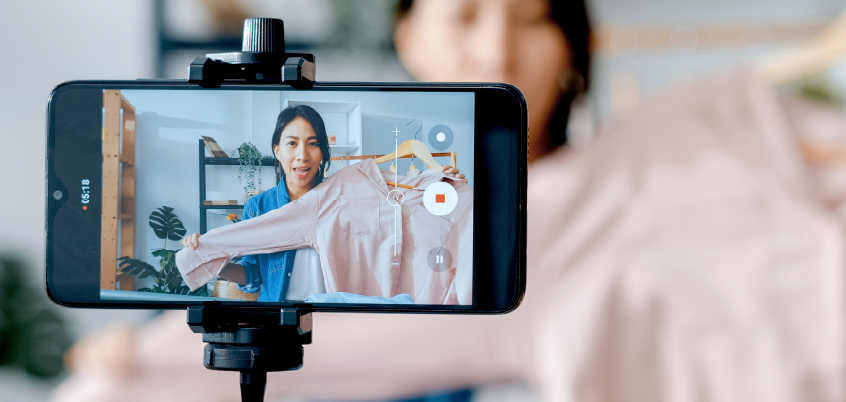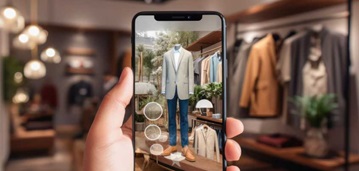5 Technology Trends Impacting Retail

The retail sector is being both challenged and enhanced by technology. Online and mobile shopping continues to threaten the existence of traditional location-based stores, but a slew of new technologies and services are working to bring customers back into stores. Others are embracing both models to create a multichannel shopping experience that blends the tangibility of in-store shopping with the convenience of ecommerce.
Read our white paper and view the infographic.
Spending to create new customer-centric shopping environments continues to rise, as retailers of all types seek to attract more customers who will spend more money. Forrester reports that 51 percent of U.S. retail sales in 2017 are digitally impacted and predicts that by 2022, 41 percent of in-store sales will be influenced by the internet.[1] It’s clear a multichannel strategy is critical to a retailer’s chance of survival in an increasingly digital-first age.
Consider, for example, shopping in a store that actively promotes the use of its mobile app while shopping. The app can determine whether the store has a particular item in stock in your size and preferred color, and you can receive instant savings coupons and even pay for the item without having to stand in line. Or visiting a “pop-up,” or temporary physical location, of an online store that is stocked with samples but has no inventory—customers can see, touch and even try on merchandise before placing their order, which is then shipped directly to them.
Indeed, retailers are moving well beyond the traditional retail or department store model to reach consumers in any way possible. Millennials and Generation Z shoppers in particular are redefining today’s retail environment: While millennials tend to do most of their shopping online, Generation Z shoppers prefer to split their shopping between online and in-store.[2] In fact, among younger Gen Z shoppers, the mall is making a comeback, with this population of shoppers enjoying the social experience ubiquitous to the mall setting. Retailers, therefore, need to ensure their customer experience is exceptional regardless of how and where their customers are.
TRENDS IN THE RETAIL SPACE
The technologies driving today’s retail environment range from the mundane to the cutting edge, all with an emphasis on attracting customers and keeping them engaged. Certain technologies, such as location-based marketing and beacons, have already proven their worth to retailers, while others—chatbots and augmented reality are two examples—are emerging as potential game-changers.
Five trends in particular—real-time inventory, flexible stores, chatbots and artificial intelligence, mobile wallet, and virtual and augmented reality—are poised to change retail for the better, by creating a seamless shopping experience that offers simplicity, flexibility, and a customer-centric environment from all channels.
REAL-TIME INVENTORY MANAGEMENT
Thanks to the rise of the internet of things (IoT), retail environments are able to service their customers faster and with more accuracy. Smart shelves, for example, can alert salespeople when stock is low and even reorder items, and they can be connected to a store’s mobile app to provide customers with real-time inventory information. This is just one technology designed to increase efficiency and enhance the customer experience, powered by IoT.
IoT is expected to be a major driver of retail moving forward, touching both customer-facing and back-office operations. In a recent survey on retail technologies, IoT was selected as the top emerging technology expected to have an impact on retail in 2018.[3]
Using RFID tags on inventory also can enable real-time inventory for retailers, giving them an at-a-glance view of where inventory is in the store at all times. An IoT-enabled inventory system can alert retailers when certain items have been abandoned or are away from their allocated place for a predetermined length of time, helping retailers locate and restock those items as quickly as possible. Returning items to their proper place immediately—such as milk or cheese back to their refrigerated sections, for example—also can help reduce spoilage and save the retailer money.
FLEXIBLE STORES
The concept of flexible stores includes both “pop-up” stores and locations with inventories that reflect the demographics of the shoppers in the area. Big-box retailer Target is one company using the flexible store concept to enter smaller or urban markets. In 2016, the company opened 30 flexible format stores in cities and near universities, carrying inventories that would appeal to customers in those areas, such as dorm room essentials and snacks in its stores close to campus, and had plans to open at least 12 stores in 2017. The flexible format stores also provided a pickup area for purchases made online, allowing shoppers to enjoy a multichannel shopping experience regardless of the size of the store.[4]
Pop-up stores, meanwhile, are temporary locations opened to capitalize on a particular trend or seasonal product, or as a way to extend a brand and introduce new products. Traditionally, online retailers can use the pop-up concept to show off their goods, while location-based retailers are opening their doors—and floor space—to host pop-up stores within their stores, such as fashion retailer Nordstrom’s pop-up store offering luxury and designer goods from London-based department store Liberty in five U.S. Nordstrom locations.[5]
CHATBOTS AND ARTIFICIAL INTELLIGENCE
The rise of big data and machine learning has ushered in a new era of predictive analytics, which is helping many retailers understand the attitudes and actions of their customers. Chatbots are the next logical technology, utilizing the power of predictive analytics and artificial intelligence to provide a more personalized level of customer service online or via a retailer’s mobile app. Chatbots can provide recommendations based on a shopper’s preferences or past purchases, help shoppers find items within a store location, and even place orders on behalf of the customer if a particular item is out of stock in the store.
Online grocery company FreshDirect is using chatbot technology to assist users in ordering groceries through a Facebook Messenger chat window. Staples, meanwhile, uses chatbots that work with Facebook Messenger, Slack, the Staples mobile app, text and email, enabling shoppers to order supplies whichever way they deem most convenient.[6]
Currently, only about 7 percent of retailers surveyed use chatbot technology, but that number is expected to grow—about 29 percent said they expect to increase their investment in chatbots over the next year. And nearly 17 percent believe chatbot technology will have an impact on retail in 2018.[7]
MOBILE WALLET
Consumers’ reliance on their smartphones is ubiquitous, and mobile payment services such as ApplePay are growing in acceptance as shoppers recognize the convenience of simply scanning or tapping their phone to make a payment.
More retailers are capitalizing on this trend by adding mobile payments to their list of mobile app features. Starbucks was an early adopter of this technology, enabling customers to simply hold their mobile phones up to a scanner to deduct payment from a prepaid account in the Starbucks app, and now a growing list of retailers, including Walmart and Target, have joined the mobile wallet movement.[8]
Mobile wallet technology also enables shoppers to check out using the mobile app rather than wait in line for a cashier, which can help enhance the overall customer experience. In addition, retailers can tie rewards and perks to their mobile wallet technology, adding yet another level of convenience for customers. For example, Kohl’s lets the retailer’s loyalty members make purchases using their reward dollars via the Kohl’s mobile app.[9]
VIRTUAL AND AUGMENTED REALITY
Perhaps the technologies with the biggest “wow” factor, virtual reality (VR) and augmented reality (AR), have the potential to change shopping habits among customers and, indeed, the retail experience as we know it. From smart mirrors that can automatically measure a customer’s dimensions and offer up the correct size in apparel and then “dress” the customer virtually, to apps that can “place” furniture pieces in a customer’s existing living quarters, AR and VR provide seemingly endless possibilities for retailers.
An April 2017 article in Forbes noted that “AR is for shoppers and VR is for businesses,” pointing out that the overlay technology in AR is more useful for visualizing how a piece of furniture will look in a customer’s living room or whether a particular shade of eye shadow will complement the customer’s complexion, for example. The immersive environment of VR, on the other hand, is extremely useful for retailers in creating store layouts or even doing remote-store “walkthroughs” using the power of analytics in combination with VR technology.[10]
Customers seem to be ready for AR. According to research from Digital Bridge, 69 percent of consumers in the U.K. expect retailers to launch AR apps within six months.[11] A survey from WorldPay, meanwhile, shows more than half of American consumers polled (55 percent) expect AR and VR to be as popular as smartphones in the near future, while nearly 70 percent believe they will go mainstream soon.[12]
HOW THE NETWORK MATTERS WITH NEW-GENERATION TECHNOLOGIES
It is clear retailers must embrace new technologies and new ways of doing business to keep up with changing customer mindsets in order to succeed in today’s multichannel shopping environment.
In embracing the next generation of technologies, retailers first must prepare their networks to certify they are able to handle the increase in traffic and demand for bandwidth. Augmented reality, real-time inventory management, mobile wallet and other technologies can stress the bandwidth of traditional networks and impact performance.
Even pop-up and flexible stores can impact a retailer’s network, as it adds and removes users and systems as new stores open and close. Add to that the bandwidth necessary to accommodate the online and in-store needs of a multichannel shopping experience, and it becomes clear existing networking infrastructures may not be able to fill the bill.
Retailers, therefore, need to ascertain if they have the right foundation for both customer-focused and back-office operations, as well as new opportunities yet to be imagined.
In building a network for the next generation of retail, organizations should consider an environment that includes both on-premises, cloud, and networking technologies such as SD-WAN and high-speed broadband to better manage business applications across all locations. And networking components such as WiFi and unified communications can ensure users of the network—retailers, their employees and their customers alike—interact and transact using their preferred method of communication.
To help ease stress on an organization’s current network—not to mention the daily burden on IT managers—managed services can be utilized to offer certain services, such as inventory control systems, without further impacting the network. Managed services can be used to help tie disparate systems together and “fill in the gaps” as retail organizations update their current infrastructure, and can prove useful even after networks have been upgraded.
Working with a network service provider can help ease the burden associated with building and maintaining a network capable of handling the bandwidth-intensive needs of the technologies powering retail today and in the future. By working with a third-party network services provider, retailers can leverage virtual and physical private Ethernet connectivity to assure critical applications perform as expected. They also can receive all or some of their most critical connectivity functions as a managed service, including managed connectivity, WiFi, security, voice and business continuity, among others.
CONCLUSION
The technology challenges faced by retailers today also have the power to be transformative, as customers increasingly prefer—and demand—a multichannel shopping experience. As such, retailers are moving well beyond the traditional retail model to reach consumers in new ways. Having the right network infrastructure in place to handle increasing bandwidth and data management needs will enable high-quality customer interaction in multichannel environments and ensure an exceptional shopping experience.
View the PDF.
View the infographic: Trends in Retail
[1] “Forrester Data: Digital-Influenced Retail Sales Forecast, 2017 To 2022,” ForecastView document, Forrester, Nov. 14, 2017 https://www.forrester.com/report/Forrester+Data+DigitalInfluenced+Retail+Sales+Forecast+2017+To+2022+US/-/E-RES140811#figure1
[2] Dennis Green, “Gen Z has a completely different shopping preference from millennials — and it’s good news for retail,” Business Insider, Oct. 7, 2017 http://www.businessinsider.com/generation-z-vs-millennials-in-shopping-2017-10
[3] “The 2017 Retail Technology Report: An Analysis of Trends, Buying Behaviors and Future Opportunities,” research paper, TotalRetail, October 2017 http://www.mytotalretail.com/resource/2017-retail-technology-report-analysis-trends-buying-behaviors-future-opportunities/file/
[4] Jonathan Berr, “Target has high hopes for its new tiny stores,” CBS MoneyWatch, Nov. 18, 2016, https://www.cbsnews.com/news/target-has-highhopes-for-its-new-tiny-stores/
[5] “Pop-Up Stores Become More Than Just a Trend,” Retail TouchPoints, https://www.retailtouchpoints.com/features/special-reports/pop-up-stores-become-more-than-just-a-trend
[6] Mai-Hanh Nguyen, “Chatbots are making online shopping and payments a breeze – see why retailers are jumping on this growing trend,” Business Insider, Oct. 13, 2017 http://www.businessinsider.com/ecommerce-trends-conversational-commerce-chatbots-2017-10
[7] “The 2017 Retail Technology Report: An Analysis of Trends, Buying Behaviors and Future Opportunities,” research paper, TotalRetail, October 2017 http://www.mytotalretail.com/resource/2017-retail-technology-report-analysis-trends-buying-behaviors-future-opportunities/file/
[8] Chance Miller, “Target launches new in-store ‘Wallet’ payment platform as it continues to resist Apple Pay,” 9to5Mac, Dec. 4, 2017 https://9to5mac.com/2017/12/04/target-wallet-in-app-in-store-payment/
[9] Olga Karif, “Mobile Wallets are the New Loyalty Program,” Bloomberg Business, Oct. 20, 2016, https://www.bloomberg.com/news/articles/2016-10-20/mobile-wallets-are-the-new-loyalty-program
[10] Nikki Baird, “In Retail, AR is For Shoppers and VR is For Business,” Forbes, April 26, 2017 https://www.forbes.com/sites/nikkibaird/2017/04/26/in-retail-ar-is-for-shoppers-and-vr-is-for-business/#2afebaac618f
[11] “Augmented Reality: Changing the Face of Retail,” research paper, Digital Bridge, September 2017 http://digitalbridge.eu//app/uploads/2017/09/DB-ChangingUKRetail_v2.pdf
[12] Adam C. Uzialko, “Businesses Bridge the VR Gap to Bring Mixed Reality to Consumers,” June 14, 2017 https://www.businessnewsdaily.com/10006-consumer-ar-vr-mixed-reality-trends.html
Key trends poised to change retail for the better, by creating an experience that offers a customer-centric environment from all channels.
Locked Content
Click on the button below to get access
Unlock NowOr sign in to access all content on Comcast Business Community
Resource Center
Learn how Comcast Business can help
keep you ready for what's next.











